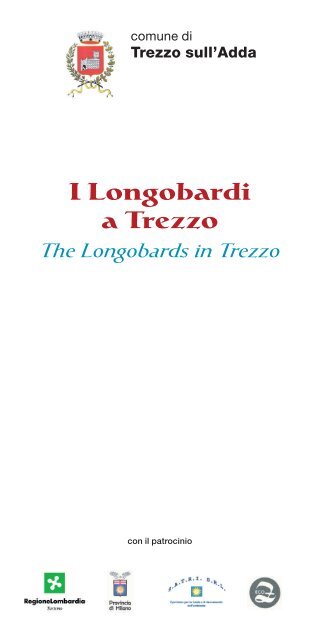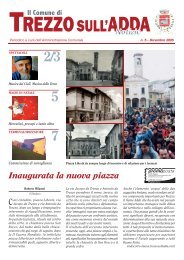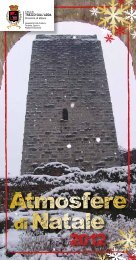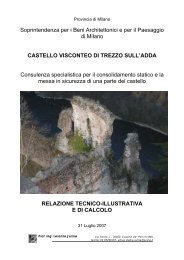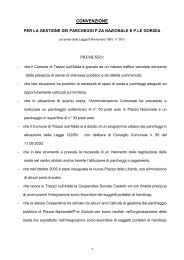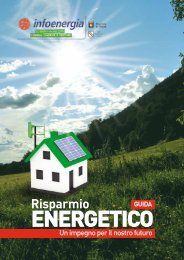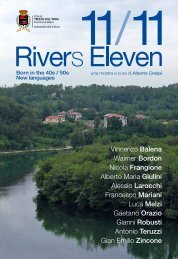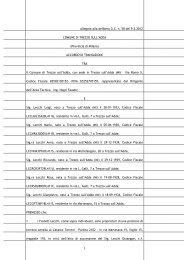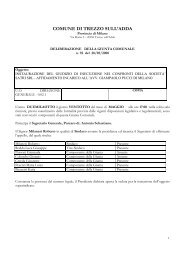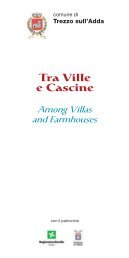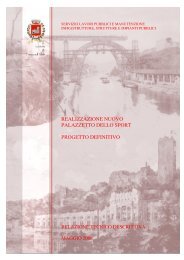I longobardi a Trezzo - Comune di Trezzo sull'Adda
I longobardi a Trezzo - Comune di Trezzo sull'Adda
I longobardi a Trezzo - Comune di Trezzo sull'Adda
Create successful ePaper yourself
Turn your PDF publications into a flip-book with our unique Google optimized e-Paper software.
comune <strong>di</strong><br />
<strong>Trezzo</strong> sull’Adda<br />
I Longobar<strong>di</strong><br />
a <strong>Trezzo</strong><br />
The Longobards in <strong>Trezzo</strong><br />
con il patrocinio
COMUNE DI<br />
TREZZO SULL’ADDA<br />
Coor<strong>di</strong>namento E<strong>di</strong>toriale<br />
Etimon - Gorgonzola - MI<br />
Telefono: 02 95304486<br />
etimon@tiscali.it / etimon@libero.it<br />
con la collaborazione<br />
<strong>di</strong> Tina Barzaghi e Maria Tinelli<br />
2<br />
Progetto grafico<br />
Walter Capp<br />
Impaginazione<br />
Dante Cavallaro<br />
Testi<br />
Marco Lissoni<br />
Traduzioni<br />
Annalisa Corti<br />
Fotografie<br />
Archivio Biblioteca “A. Manzoni”,<br />
Foto Fumagalli - <strong>Trezzo</strong>, Albertina Quadri<br />
Fotolito e stampa Ba.Ma - <strong>Trezzo</strong> s/A
T<br />
In<strong>di</strong>ce / Index<br />
I Longobar<strong>di</strong> a <strong>Trezzo</strong><br />
The Longobards in <strong>Trezzo</strong><br />
La necropoli <strong>di</strong> <strong>Trezzo</strong> . . . . . . . . . . . . . . . . . . . . . . . . . . . . . . . . . . . . . . . . . . . . . . . . . . . . . . . . . . . . . . . . . . 4<br />
The necropolis of <strong>Trezzo</strong><br />
Il luogo del primo ritrovamento / The place of the first <strong>di</strong>scovery<br />
Le tombe / The graves<br />
I materiali / The materials<br />
Le altre tombe <strong>di</strong> <strong>Trezzo</strong> . . . . . . . . . . . . . . . . . . . . . . . . . . . . . . . . . . . . . . . . . . . . . . . . . . . . . . . . . . . . 20<br />
The other graves of <strong>Trezzo</strong><br />
L’inse<strong>di</strong>amento romano / The Roman settlement<br />
L’area dell’antica chiesa / The area of the ancient church<br />
La necropoli <strong>di</strong> San Martino / The Saint Martin necropolis<br />
I Longobar<strong>di</strong> in Italia . . . . . . . . . . . . . . . . . . . . . . . . . . . . . . . . . . . . . . . . . . . . . . . . . . . . . . . . . . . . . . . . . . . 36<br />
The Longobards in Italy<br />
I caratteri del regno longobardo / The characters of the Longobard kingdom<br />
La caduta del regno / The fall of the kingdom<br />
La planimetria degli scavi . . . . . . . . . . . . . . . . . . . . . . . . . . . . . . . . . . . . . . . . . . . . . . . . . . . . . . . 44<br />
The map of excavations<br />
Informazioni . . . . . . . . . . . . . . . . . . . . . . . . . . . . . . . . . . . . . . . . . . . . . . . . . . . . . . . . . . . . . . . . . . . . . . . . . . . . . . . . . . . . . . . . . . 46<br />
Information<br />
Come arrivare a <strong>Trezzo</strong> sull’Adda / How to get to <strong>Trezzo</strong> sull’Adda<br />
Dove parcheggiare / Parking<br />
Noleggio biciclette / Bicycle hire<br />
In<strong>di</strong>rizzi utili / Useful Addresses<br />
Curiosità . . . . . . . . . . . . . . . . . . . . . . . . . . . . . . . . . . . . . . . . . . . . . . . . . . . . . . . . . . . . . . . . . . . . . . . . . . . . . . . . . . . . . . . . . . . . . . . . . . . . . . 48<br />
Curiosity<br />
3
La necropoli<br />
<strong>di</strong> <strong>Trezzo</strong><br />
The necropolis of <strong>Trezzo</strong><br />
4<br />
Tomba scoperta nel secondo<br />
ritrovamento (scavi anni 1990/92)<br />
in zona Cascina S.Martino<br />
The grave belonging to the necropolis<br />
found in 1990/92 in the area<br />
of Saint Martin farmhouse
T<br />
La necropoli <strong>di</strong> <strong>Trezzo</strong><br />
The necropolis of <strong>Trezzo</strong><br />
Subito agli stu<strong>di</strong>osi<br />
risultò evidente un fatto:<br />
si trattava <strong>di</strong> tombe <strong>di</strong><br />
personaggi <strong>di</strong> rango molto<br />
elevato. Forse ricchi<br />
proprietari terrieri, più<br />
probabilmente funzionari<br />
<strong>di</strong> alto livello sociale ed<br />
economico, legati al<br />
sovrano da un rapporto<br />
<strong>di</strong>retto e privilegiato.<br />
Ne era testimonianza certa<br />
il prezioso materiale<br />
rinvenuto nella piccola<br />
necropoli, scoperta per<br />
caso nel 1976 alla periferia<br />
dell’abitato.<br />
Un ritrovamento tanto<br />
casuale quanto<br />
impreve<strong>di</strong>bile, per la<br />
completa mancanza <strong>di</strong><br />
fonti storiche che<br />
testimoniassero una<br />
presenza longobarda<br />
nell’area <strong>di</strong> <strong>Trezzo</strong><br />
sull’Adda già agli inizi del<br />
VII secolo.<br />
Una scoperta archeologica<br />
sensazionale, che <strong>di</strong> colpo<br />
5<br />
T<br />
he experts imme<strong>di</strong>ately<br />
realised something: they<br />
were graves of high-ranking<br />
people. Maybe rich<br />
landowners, more likely<br />
officers of a high social and<br />
economic level, bound to the<br />
king by a <strong>di</strong>rect and privileged<br />
relationship. The precious<br />
material <strong>di</strong>scovered in the<br />
small necropolis, which was<br />
found by chance in the<br />
suburbs of the built-up area in<br />
1976, could prove it. This<br />
<strong>di</strong>scovery was as accidental as<br />
unforeseeable, because of the<br />
entire lack of historical sources<br />
that could prove the presence<br />
of the Longobards in the area<br />
of <strong>Trezzo</strong> sull’Adda already at<br />
the beginning of the VII<br />
century. It was a sensational<br />
archaeological <strong>di</strong>scovery,<br />
Scavi / Excavations
T<br />
La necropoli <strong>di</strong> <strong>Trezzo</strong><br />
The necropolis of <strong>Trezzo</strong><br />
gettava una luce nuova non<br />
solo sulla storia dell’abitato<br />
nell’alto me<strong>di</strong>oevo, ma<br />
anche sulle vicende stesse<br />
dei Longobar<strong>di</strong> in Italia e<br />
sul loro inse<strong>di</strong>amento nei<br />
territori lungo l’Adda.<br />
Eppure, per ritrovamenti<br />
eccellenti <strong>Trezzo</strong> era già<br />
nota: qui, infatti, nel 1846<br />
venne rinvenuta una situla,<br />
oggi custo<strong>di</strong>ta al Castello<br />
Sforzesco <strong>di</strong> Milano tra i<br />
reperti delle Civiche<br />
raccolte archeologiche e<br />
numismatiche. Il prezioso<br />
vaso in rame, databile al<br />
IV-III secolo a.C., darebbe<br />
testimonianza dell’origine<br />
celtica dell’abitato, per sette<br />
secoli dominato da Roma e<br />
6<br />
Pianta della tomba<br />
n. 1 (primo scavo 1976/78)<br />
Map of the grave n. 1 (first<br />
excavation 1976/78)<br />
which suddenly threw a new<br />
light not only on the history of<br />
the High Middle Age, but also<br />
on the very events of the<br />
Longobards in Italy and on<br />
their settlement in the areas<br />
along the river Adda.<br />
Nevertheless, <strong>Trezzo</strong> had<br />
already been famous for<br />
excellent <strong>di</strong>scoveries: here, as<br />
a matter of fact, a situla,<br />
a funerary urn, was found in<br />
1846. Today this urn is kept<br />
in the Sforza Castle in Milan<br />
among the other pieces of the<br />
Civic archaeological and<br />
numismatic collections. The<br />
precious vase made of copper,<br />
dating back to the IV-III<br />
centuries BC, probably proved<br />
the Celtic origin of the built-
T<br />
La necropoli <strong>di</strong> <strong>Trezzo</strong><br />
The necropolis of <strong>Trezzo</strong><br />
<strong>di</strong>venuto poi parte dei<br />
posse<strong>di</strong>menti <strong>longobar<strong>di</strong></strong>,<br />
che dalle valli del Natisone<br />
(Friuli) si estesero in breve<br />
a tutti i territori padani.<br />
Il luogo del primo<br />
ritrovamento<br />
In località San Martino, a<br />
nord-ovest <strong>di</strong> <strong>Trezzo</strong>, venne<br />
decisa nel 1976 la<br />
costruzione <strong>di</strong> un nuovo<br />
e<strong>di</strong>ficio. La situazione era<br />
favorevole all’inse<strong>di</strong>amento<br />
<strong>di</strong> un complesso abitativo:<br />
l’area, poco <strong>di</strong>stante dalla<br />
strada provinciale Monza-<br />
<strong>Trezzo</strong> e vicina all’ampia<br />
ansa formata dall’Adda a<br />
settentrione dell’abitato,<br />
era già ampiamente<br />
urbanizzata e, dunque,<br />
dotata <strong>di</strong> tutte le<br />
infrastrutture necessarie.<br />
Così l’area assumeva<br />
sempre più un aspetto<br />
7<br />
up area, dominated by the<br />
Romans for seven centuries<br />
and then part of the<br />
Longobard possessions, which<br />
quickly spread across all the<br />
Po territories from the valley<br />
of Natisone (Friuli).<br />
The place<br />
of the first <strong>di</strong>scovery<br />
The construction of a new<br />
buil<strong>di</strong>ng was decided in Saint<br />
Martin, a place in the<br />
Northwest of <strong>Trezzo</strong>, in 1976.<br />
The situation was favourable<br />
for the creation of a<br />
residential complex: the area,<br />
not far from the provincial<br />
road Monza-<strong>Trezzo</strong> and near<br />
the wide loop created by the<br />
river Adda in the north of the<br />
inhabited area, had already<br />
been widely urbanised and,<br />
consequently, provided with<br />
all the necessary<br />
infrastructures.<br />
Therefore this area was<br />
looking more and more<br />
“urban”, and certainly, could<br />
not let people foresee the<br />
unexpected <strong>di</strong>scovery of a<br />
High Middle Age necropolis,<br />
which saw the light of the day<br />
during the excavation to lay<br />
the foundations of the<br />
modern buil<strong>di</strong>ng. So, this<br />
accidental case linked the<br />
Punta <strong>di</strong> lancia, spada e parte <strong>di</strong> umbone<br />
Point of a lance, sword and centre of a shield
T<br />
La necropoli <strong>di</strong> <strong>Trezzo</strong><br />
The necropolis of <strong>Trezzo</strong><br />
‘urbano’ che, certo, non<br />
poteva lasciar presagire<br />
l’inattesa scoperta <strong>di</strong> una<br />
necropoli <strong>di</strong> età<br />
altome<strong>di</strong>evale, venuta alla<br />
luce nello scavo per gettare<br />
le fondamenta del<br />
moderno palazzo. Un caso<br />
fortuito, dunque, che ha<br />
legato il nome <strong>di</strong> <strong>Trezzo</strong> al<br />
più ricco e interessante<br />
ritrovamento longobardo<br />
<strong>di</strong> tutta la regione.<br />
Le tombe<br />
La Soprintendenza<br />
Archeologica della<br />
Lombar<strong>di</strong>a <strong>di</strong>resse lo scavo,<br />
effettuato tra il mese <strong>di</strong><br />
settembre 1976 e il mese <strong>di</strong><br />
marzo 1978 sia sul campo<br />
che in laboratorio, con<br />
l’asportazione dei pani <strong>di</strong><br />
terra contenenti il corredo.<br />
Cinque le sepolture venute<br />
alla luce, e tutte maschili.<br />
Cinque tombe a camera<br />
8<br />
name of <strong>Trezzo</strong> with the<br />
richest and most interesting<br />
Longobard <strong>di</strong>scovery in the<br />
entire region.<br />
The graves<br />
The Archaeological<br />
Superintendence of<br />
Lombardy supervised the<br />
excavation, which was carried<br />
out from September 1976 to<br />
March 1978 both on the field<br />
and in laboratory, with the<br />
removal of the pieces of land<br />
containing the <strong>di</strong>scovery.<br />
They found five graves with<br />
wooden coffins, datable to the
9<br />
Particolare <strong>di</strong> una tomba<br />
con alcuni oggetti<br />
del corredo funebre.<br />
Nella pagina precedente<br />
operazioni <strong>di</strong> scavo<br />
Detail of a grave<br />
with some objects gathered<br />
in the ground.<br />
Page 8: excavations
T<br />
La necropoli <strong>di</strong> <strong>Trezzo</strong><br />
The necropolis of <strong>Trezzo</strong><br />
con bara lignea, databili al<br />
VII secolo, <strong>di</strong>sposte su due<br />
file parallele e orientate in<br />
<strong>di</strong>rezione est-ovest.<br />
Coperchi in serizzo a due<br />
falde coprivano le<br />
sepolture, tutte - a<br />
esclusione della prima, in<br />
mattoni - costituite da<br />
lastroni <strong>di</strong> pietra irregolari<br />
ricavati da più antichi<br />
sarcofagi romani e in<br />
alcuni casi (tomba n. 2 e<br />
tomba n. 5) rivestite <strong>di</strong><br />
pietre o frammenti <strong>di</strong><br />
tegole.<br />
10<br />
VII century, which were<br />
<strong>di</strong>sposed in two parallel rows<br />
going from east towards west.<br />
Covers made of two stone<br />
strata closed the graves, and<br />
two irregular large stony slabs<br />
formed all of them - apart<br />
from the first one, which was<br />
made of bricks. These slabs<br />
were taken from more ancient<br />
Roman sarcophagi and in<br />
some cases (grave n. 2 and<br />
grave n. 5) tiled with stones or<br />
fragments of tiles.<br />
It stood imme<strong>di</strong>ately to reason<br />
that it was a noble necropolis.<br />
Pianta della<br />
tomba n. 2<br />
(scavi anni<br />
1976/78)<br />
Map of the<br />
grave n. 2<br />
(excavations<br />
1976/78)
T<br />
La necropoli <strong>di</strong> <strong>Trezzo</strong><br />
The necropolis of <strong>Trezzo</strong><br />
Che si trattasse <strong>di</strong> una<br />
necropoli nobiliare<br />
apparve subito evidente: i<br />
reperti contenuti in tutte le<br />
tombe denunciavano<br />
l’appartenenza dei defunti<br />
a un rango sociale ed<br />
economico molto elevato,<br />
documentata anche dopo<br />
la morte da anelli-sigillo,<br />
ricchi paramenti e<br />
guarnizioni in broccato.<br />
Proprio la presenza <strong>di</strong><br />
sigilli usati in atti pubblici<br />
confermerebbe che -<br />
almeno per tre <strong>di</strong> queste<br />
tombe - si è alla presenza <strong>di</strong><br />
alti funzionari regi, quei<br />
gastal<strong>di</strong> che<br />
amministravano le terre e<br />
Umbone dello scudo<br />
Centre of the shield<br />
11<br />
The objects contained in all<br />
the graves showed the fact that<br />
the dead belonged to a very<br />
high social and economic<br />
rank, which was still proved<br />
after their death by the sealrings,<br />
the rich vestments and<br />
the brocade ornaments they<br />
were buried with. The very<br />
presence of these seals, which<br />
were used during public acts,<br />
probably confirmed - at least<br />
for three of these graves - that<br />
they belonged to high royal<br />
officers, the so called gastal<strong>di</strong>,<br />
who controlled the lands and<br />
upon whom the Longobard<br />
kingdom in Italy turned. This<br />
rea<strong>di</strong>ng, put forward by the<br />
archaeologists, certainly<br />
confirms the extraor<strong>di</strong>nary<br />
importance of this <strong>di</strong>scovery<br />
in <strong>Trezzo</strong>.
T<br />
La necropoli <strong>di</strong> <strong>Trezzo</strong><br />
The necropolis of <strong>Trezzo</strong><br />
costituivano il perno del<br />
regno longobardo in Italia.<br />
E questa lettura avanzata<br />
dagli archeologi certo<br />
conferma il rilievo<br />
straor<strong>di</strong>nario della scoperta<br />
<strong>di</strong> <strong>Trezzo</strong>.<br />
Solido aureo <strong>di</strong> Foca, <strong>di</strong>ritto e rovescio<br />
Gold solid of Foca (observe and reverse)<br />
I personaggi sepolti nella<br />
necropoli erano<br />
verosimilmente uniti da<br />
legami <strong>di</strong> parentela. Una<br />
necropoli ‘familiare’,<br />
dunque. Ma perché solo<br />
maschile? L’ipotesi più<br />
accre<strong>di</strong>tata è che una parte<br />
delle tombe sia andata<br />
completamente <strong>di</strong>strutta,<br />
per la presenza in questa<br />
zona <strong>di</strong> cave <strong>di</strong> argilla<br />
anche in un passato<br />
lontano. Le indagini<br />
effettuate in seguito<br />
nell’area della necropoli,<br />
con circa ottanta saggi a<br />
<strong>di</strong>stanza ravvicinata e su<br />
file parallele, <strong>di</strong>edero infatti<br />
risultati negativi.<br />
12<br />
Family ties probably bound<br />
the people buried in this<br />
necropolis. Well, a<br />
“domestic” necropolis. But<br />
why only male? The most<br />
accre<strong>di</strong>ted supposition is that<br />
part of the graves was<br />
completely destroyed in an<br />
age far removed from our<br />
own, for the presence in this<br />
area of clay quarries. As a<br />
matter of fact, the following<br />
research made in the area of<br />
the necropolis, with about<br />
eighty tests at a close<br />
<strong>di</strong>stance in parallel rows,<br />
gave negative results.<br />
The materials<br />
The exam of the precious<br />
funeral objects <strong>di</strong>scovered in<br />
the graves turned out to be<br />
particularly interesting. They<br />
gave the experts new elements<br />
to understand the Longobard<br />
social organisation, the<br />
material culture of those<br />
people coming from the far<br />
“Pannonia” and the links and<br />
the relationships between the
T<br />
La necropoli <strong>di</strong> <strong>Trezzo</strong><br />
The necropolis of <strong>Trezzo</strong><br />
I materiali<br />
Particolarmente<br />
interessante risultò l’esame<br />
dei ricchi corre<strong>di</strong> funebri<br />
rinvenuti nelle tombe, che<br />
<strong>di</strong>ede agli stu<strong>di</strong>osi nuovi<br />
Anello aureo con gemma<br />
Gold ring with gem<br />
elementi per comprendere<br />
l’organizzazione sociale<br />
longobarda, la cultura<br />
materiale <strong>di</strong> quel popolo<br />
venuto dalla lontana<br />
Pannonia, i contatti e i<br />
Guarnizioni della cintura<br />
Ornaments of the belt<br />
13<br />
<strong>di</strong>fferent centres of their<br />
kingdom in Italy.<br />
As a matter of fact, the<br />
Longobard necropolis of<br />
<strong>Trezzo</strong> gave back an<br />
extraor<strong>di</strong>nary patrimony of<br />
refined, precious objects. They<br />
are ornaments showing the<br />
rank of the dead and symbols<br />
of the power they were given<br />
by the king. Golden yarns of a<br />
brocade cloth, double-edged<br />
swords (the typical spatha,<br />
used all over the Merovingian<br />
area) with silver hilts and<br />
golden decorations on their<br />
Crocette in lamine d’oro<br />
Pale gold leaf crosses<br />
sheaths, belts made of<br />
Byzantine gold, crosses made<br />
of pale gold leaf with<br />
interlaced embossed works, a<br />
seal ring with a gem (a red<br />
cornelian) with a crab carved<br />
on it. And then arrows of<br />
<strong>di</strong>fferent styles, shorter swords<br />
with one edge (sax) suitable<br />
for a close fighting on horses,
T<br />
La necropoli <strong>di</strong> <strong>Trezzo</strong><br />
The necropolis of <strong>Trezzo</strong><br />
legami tra i <strong>di</strong>versi centri<br />
del loro regno in Italia.<br />
La necropoli longobarda <strong>di</strong><br />
<strong>Trezzo</strong> ha infatti restituito<br />
un patrimonio<br />
straor<strong>di</strong>nario <strong>di</strong> oggetti<br />
raffinati e preziosi. Sono<br />
ornamenti che<br />
testimoniano il rango dei<br />
defunti e simboli <strong>di</strong> quel<br />
potere che il sovrano aveva<br />
loro conferito. Fili d’oro<br />
appartenuti a un tessuto<br />
broccato, spade a doppio<br />
taglio (la tipica spatha,<br />
comune a tutta l’area<br />
merovingia) con<br />
impugnatura in argento e<br />
decorazioni auree nel<br />
fodero, cinture in oro <strong>di</strong><br />
tipo bizantino, croci in<br />
lamina d’oro con motivi a<br />
sbalzo intrecciati, un anello<br />
sigillo con gemma (corniola<br />
<strong>di</strong> colore rosso) incastonata<br />
Bacile (scavi anni 1990/92)<br />
Basin (excavations 1990/92)<br />
14<br />
belts made of damask iron, (a<br />
particular joint<br />
metalworking), finely<br />
decorated spurs and<br />
ornaments and gold coins.<br />
Everything proves that the<br />
Longobards were not the<br />
barbaric, rough people they<br />
were believed to be.<br />
However, the most important<br />
<strong>di</strong>scoveries are two seal rings<br />
made of fused gold, <strong>di</strong>scovered<br />
in grave 2 and in grave 4. Both<br />
of them have the image of a<br />
bearded man, with a hairparting<br />
in the middle, but<br />
while on the first seal the<br />
manly figure is surrounded by<br />
the inscription rdc hisvil<br />
(rodchis vir illustris), on the<br />
second one it is surrounded by<br />
the inscription ansu aldo,<br />
written upside down. The<br />
experts have made the<br />
supposition - also confirmed
15<br />
Scavi a una tomba (anni 1976/78)<br />
First excavation<br />
occurred between 1976/78
T<br />
La necropoli <strong>di</strong> <strong>Trezzo</strong><br />
The necropolis of <strong>Trezzo</strong><br />
con inciso un granchio. E<br />
ancora scu<strong>di</strong> da parata,<br />
fibbie in bronzo, cuspi<strong>di</strong> <strong>di</strong><br />
lance e punte <strong>di</strong> freccia <strong>di</strong><br />
fogge <strong>di</strong>verse, spade più<br />
corte a unico taglio (sax)<br />
adatte al combattimento<br />
ravvicinato da cavallo,<br />
cinture in ferro ageminato<br />
(particolare lavorazione a<br />
incastro <strong>di</strong> metalli), speroni<br />
e guarnizioni finemente<br />
decorate, monete d’oro.<br />
Tutto testimonia quanto i<br />
Longobar<strong>di</strong> non furono<br />
certo quel popolo barbaro e<br />
rozzo che si credeva un<br />
tempo.<br />
I reperti più notevoli sono<br />
però due anelli-sigillo in<br />
oro fuso, rinvenuti nella<br />
tomba 2 e nella tomba 4.<br />
Entrambi portano l’effigie<br />
<strong>di</strong> un uomo barbuto, con i<br />
capelli <strong>di</strong>visi da una<br />
scriminatura centrale, ma<br />
nel primo sigillo la figura<br />
virile è circondata dalla<br />
16<br />
Pianta della tomba n. 3<br />
(primo scavo 1976/78)<br />
Map of the grave n.3<br />
(first excavation 1976/78)<br />
Impugnatura Spatha<br />
Hilt of the Spatha
T<br />
La necropoli <strong>di</strong> <strong>Trezzo</strong><br />
The necropolis of <strong>Trezzo</strong><br />
legenda RDC HIS V IL<br />
(Rodchis vir illustris),<br />
mentre nel secondo è<br />
coronata dalla scritta<br />
ANSV ALDO a rovescio.<br />
Gli stu<strong>di</strong>osi hanno<br />
avanzato l’ipotesi - peraltro<br />
confermata da altri<br />
ritrovamenti in territori<br />
<strong>longobar<strong>di</strong></strong> - che il<br />
personaggio maschile<br />
rappresenti un sovrano<br />
longobardo, la cui incerta<br />
caratterizzazione<br />
fisionomica è comune alle<br />
raffigurazioni che<br />
compaiono sulle monete<br />
bizantine del tempo. Le<br />
scritte attorno si<br />
riferiscono invece ai<br />
possessori degli anellisigillo,<br />
funzionari regi che<br />
siglavano gli atti pubblici<br />
con il loro nome e l’effigie<br />
del re. Questi ‘signori degli<br />
anelli’, il cui rango è<br />
sottolineato in un caso<br />
dalla qualifica <strong>di</strong> vir<br />
illustris,appartenevano<br />
dunque alla classe <strong>di</strong>rigente<br />
del regno longobardo,<br />
legata al sovrano da vincoli<br />
particolarmente stretti.<br />
Erano cioè gastal<strong>di</strong>,<br />
rappresentanti del potere<br />
politico e militare,<br />
espressione <strong>di</strong>retta<br />
dell’autorità centrale e<br />
amministratori dei vasti<br />
posse<strong>di</strong>menti della corona.<br />
17<br />
by <strong>di</strong>scoveries in other<br />
Longobard territories - that<br />
the male figure represents a<br />
Longobard king, whose<br />
uncertain face can be found on<br />
Byzantine coins of that period<br />
too. The inscription around it<br />
refers to the owners of the seal<br />
rings, royal officers, who<br />
initialled the public acts with<br />
their names and the image of<br />
the king. These “lords of the<br />
rings”, whose rank is<br />
underlined in one case by the<br />
title vir illustris, belonged to<br />
the lea<strong>di</strong>ng class of the<br />
Longobard kingdom, bound to<br />
the king by very close ties. They<br />
were gastal<strong>di</strong>, representatives<br />
of the political and military<br />
power, <strong>di</strong>rect expression of the<br />
central authority and<br />
administrators of the wide<br />
possessions of the king.<br />
Parte della spada con anelli<br />
Part of the sword with rings
19<br />
All’interno del<br />
Castello e della Villa<br />
Comunale <strong>di</strong> <strong>Trezzo</strong> sono<br />
rimaste soltanto alcune<br />
tombe che, ricostruite,<br />
da qualche anno si possono<br />
visitare<br />
Inside the Castle and<br />
the Villa Comunale (the<br />
Town Hall buil<strong>di</strong>ng) of <strong>Trezzo</strong><br />
there are only some properly<br />
rebuilt graves, which can be<br />
visited for a couple of years.<br />
“Tomba del gigante”, ricostruita<br />
nel 1993 e visitabile nei sotterranei<br />
della Villa del Castello Visconteo.<br />
Altre tombe sono collocate nel<br />
giar<strong>di</strong>no della Villa Comunale<br />
“The Grave of the Giant”, rebuilt<br />
in 1993, can be seen in the cellar<br />
of the Villa of the Visconti Castle.<br />
Other graves can be found<br />
in the park of the Villa Comunale<br />
(Town Hall Buil<strong>di</strong>ng)
Le altre tombe<br />
<strong>di</strong> <strong>Trezzo</strong><br />
The other graves of <strong>Trezzo</strong><br />
20
T<br />
Le altre tombe <strong>di</strong> <strong>Trezzo</strong><br />
The other graves of <strong>Trezzo</strong><br />
Nel 1988 un nuovo<br />
progetto e<strong>di</strong>lizio<br />
interessò l’area della<br />
vecchia cascina San<br />
Martino, ormai in degrado.<br />
La demolizione dei corpi <strong>di</strong><br />
fabbrica <strong>di</strong> origine<br />
ottocentesca per la<br />
costruzione <strong>di</strong> un nuovo<br />
condominio venne però<br />
vincolata dalla<br />
Soprintendenza<br />
Archeologica della<br />
Lombar<strong>di</strong>a alla preventiva<br />
esplorazione dell’area. La<br />
relativa vicinanza alla<br />
necropoli scoperta nel 1976<br />
- solo 200 metri in linea<br />
d’aria - suggeriva infatti<br />
molta cautela nello scavo <strong>di</strong><br />
nuove fondamenta, tanto<br />
che le indagini<br />
archeologiche preliminari<br />
vennero precedute da<br />
attente esplorazioni<br />
geofisiche.<br />
21<br />
In the area of the old Saint<br />
Martin farmhouse a new<br />
buil<strong>di</strong>ng project was started<br />
in 1988. The buil<strong>di</strong>ng was<br />
decaying by that time.<br />
However, the demolition of<br />
the seventeenth-century<br />
factory pieces for the<br />
construction of a new block<br />
of flats was bound by the<br />
Archaeological<br />
Superintendence of<br />
Lombardy to a preventive<br />
exploration of the area. As a<br />
matter of fact, the relative<br />
closeness to the necropolis<br />
found in 1976 - just 200<br />
metres in a bee-line -<br />
suggested some caution when<br />
new foundations had to be<br />
laid, so that the preventive<br />
archaeological research was<br />
preceded by careful<br />
geophysical explorations.<br />
Operazioni <strong>di</strong> scavo;<br />
nella pagina precedente<br />
l’interno <strong>di</strong> una tomba<br />
(scavi 1976/78)<br />
Excavations on the other<br />
page: inside of a grave<br />
(excavations 1976/78)
T<br />
Le altre tombe <strong>di</strong> <strong>Trezzo</strong><br />
The other graves of <strong>Trezzo</strong><br />
L’inse<strong>di</strong>amento<br />
romano<br />
La prima fase <strong>di</strong> scavo,<br />
effettuata tra gennaio e<br />
luglio 1989, evidenziò che<br />
l’area della cascina San<br />
Martino era già abitata in<br />
età romana. La presenza <strong>di</strong><br />
un inse<strong>di</strong>amento rurale,<br />
attivo per tutta l’età<br />
imperiale e fino all’alto<br />
me<strong>di</strong>oevo, fu confermata<br />
dal ritrovamento <strong>di</strong> una<br />
grande quantità <strong>di</strong><br />
materiali d’uso. Emerse in<br />
particolare una cisterna per<br />
l’acqua con pareti in<br />
ciottoli e rivestimento in<br />
cocciopesto, riempita nella<br />
fase <strong>di</strong> abbandono da<br />
terreno abbastanza<br />
22<br />
Pianta della<br />
tomba n. 4<br />
(primo scavo<br />
1976/78)<br />
Map of the<br />
grave n. 4<br />
(first excavation<br />
1976/78)<br />
The Roman<br />
settlement<br />
The first phase of the<br />
excavation, carried out from<br />
January to July 1989,<br />
underlined the fact that the<br />
area of Saint Martin<br />
farmhouse had already been<br />
inhabited during the Roman<br />
age. The presence of a rural<br />
settlement, for all the<br />
imperial time and until the<br />
High Middle Age, was<br />
confirmed by the <strong>di</strong>scovery of<br />
a great quantity of materials.<br />
In particular, they found a<br />
water tank with pebbly walls<br />
and covered with<br />
earthenware, filled in the<br />
phase of abandonment with a<br />
quite homogeneous soil, rich
T<br />
Le altre tombe <strong>di</strong> <strong>Trezzo</strong><br />
The other graves of <strong>Trezzo</strong><br />
omogeneo, ricco <strong>di</strong> cocci<br />
ceramici, resti <strong>di</strong> strutture<br />
romane e ossa <strong>di</strong> animali.<br />
Col proseguimento della<br />
campagna <strong>di</strong> scavo vennero<br />
alla luce altre buche,<br />
utilizzate come <strong>di</strong>scariche e<br />
riempite <strong>di</strong> macerie. Tra<br />
tutte, particolarmente<br />
interessante per la<br />
stratificazione e la varietà dei<br />
materiali si rivelò una<br />
profonda fossa a pareti<br />
verticali, del <strong>di</strong>ametro <strong>di</strong><br />
circa <strong>di</strong>eci metri e profonda<br />
più <strong>di</strong> quattro.<br />
Originariamente utilizzata<br />
per l’estrazione <strong>di</strong> argilla<br />
necessaria alla produzione <strong>di</strong><br />
laterizi, venne in seguito<br />
riempita con rifiuti<br />
domestici e macerie ottenute<br />
dalla demolizione <strong>di</strong> e<strong>di</strong>fici<br />
romani (cocci <strong>di</strong> laterizi,<br />
ciottoli, piastrelle<br />
23<br />
in bits and pieces of ceramics,<br />
remains of Roman buil<strong>di</strong>ngs<br />
and animal bones.<br />
As the excavation was<br />
procee<strong>di</strong>ng they <strong>di</strong>scovered<br />
other holes, which were used<br />
as dumps and filled with<br />
ruins. Among these, a deep<br />
hole with vertical walls, whose<br />
<strong>di</strong>ameter was about ten<br />
meters and whose depth was<br />
over four meters, turned out<br />
to be particularly interesting<br />
for its stratification and the<br />
variety of materials. It was<br />
originally used to quarry the<br />
clay necessary for the<br />
production of bricks and then<br />
filled with domestic waste and<br />
ruins of demolished Roman<br />
buil<strong>di</strong>ngs (fragments of<br />
bricks, pebbles, floor tiles,<br />
Una tomba prima e dopo l’apertura<br />
A grave before and after being opened
T<br />
Le altre tombe <strong>di</strong> <strong>Trezzo</strong><br />
The other graves of <strong>Trezzo</strong><br />
pavimentali, resti <strong>di</strong><br />
intonaco) come la cisterna<br />
per l’acqua e le buche più<br />
piccole.<br />
L’area dell’antica<br />
chiesa<br />
Negli anni seguenti le<br />
attività <strong>di</strong> esplorazione e<br />
scavo condotte dalla<br />
Soprintendenza<br />
Archeologica si<br />
concentrarono nel luogo<br />
I due anelli<br />
sigillo: sopra<br />
Ansu Aldo;<br />
a fianco<br />
Rodchis<br />
The two seal<br />
rings: above<br />
Ansu Aldo; on<br />
the right<br />
Rodchis<br />
24<br />
remains of plaster) like the<br />
water tank and the smaller<br />
holes.<br />
The area<br />
of the ancient church<br />
In the following years, the<br />
explorations and the<br />
excavations carried out by the<br />
Archaeological<br />
Superintendence focused on<br />
the place where once there<br />
was the ancient Saint Martin<br />
church, which does not exist<br />
anymore. What remains of<br />
this church - already supplied<br />
with documentary evidence<br />
in the XIII century - is only a<br />
memory in the name of the<br />
place. Built inside a<br />
farmhouse at the beginning of<br />
the Nineteenth century, the<br />
temple was demolished<br />
around 1920, when
T<br />
Le altre tombe <strong>di</strong> <strong>Trezzo</strong><br />
The other graves of <strong>Trezzo</strong><br />
un tempo occupato<br />
dall’antica chiesa <strong>di</strong> San<br />
Martino, non più esistente.<br />
Dell’antica chiesa de<strong>di</strong>cata<br />
al santo- già documentata a<br />
partire dal XIII secolo -<br />
rimaneva solo il ricordo nel<br />
nome del luogo: inglobato<br />
in una cascina agli inizi<br />
dell’Ottocento, il tempio<br />
era stato infatti abbattuto<br />
intorno al 1920, quando<br />
furono intrapresi pesanti<br />
lavori <strong>di</strong> ristrutturazione<br />
del nucleo rurale<br />
ottocentesco. Gli ampi<br />
rifacimenti e la costruzione<br />
<strong>di</strong> nuovi e<strong>di</strong>fici avevano<br />
così irrime<strong>di</strong>abilmente<br />
cancellato la presenza<br />
dell’antico e<strong>di</strong>ficio <strong>di</strong> culto,<br />
che agli inizi del Settecento,<br />
nelle mappe del catasto<br />
teresiano, appariva ancora<br />
solenne e solitario a circa<br />
un miglio dall’abitato.<br />
Nell’area in cui sorgeva<br />
l’e<strong>di</strong>ficio <strong>di</strong> culto vennero<br />
così alla luce, nel 1990-91,<br />
altri resti romani <strong>di</strong> incerta<br />
attribuzione, secondo<br />
alcuni stu<strong>di</strong>osi<br />
riconducibili alla presenza<br />
<strong>di</strong> una villa rustica.<br />
Fili aurei ancora inseriti nel terreno<br />
(sopra) e dopo il lavoro <strong>di</strong> pulitura<br />
Gold yarn still in the ground<br />
and after being cleaned<br />
25<br />
important restoration works<br />
of the nineteenth-century<br />
rural core were started. The<br />
big reconstruction and the<br />
construction of new buil<strong>di</strong>ngs<br />
had irreme<strong>di</strong>ably cancelled<br />
the presence of the ancient<br />
church, which, at the<br />
beginning of the Eighteenth<br />
century, still appeared on the<br />
maps of the land office solemn<br />
and lonely about one mile far<br />
from the built-up area. In the<br />
area where the church laid,<br />
other Roman ruins of<br />
doubtful origin came to light<br />
in 1990-1991 and, accor<strong>di</strong>ng<br />
to some experts, they were<br />
part of a country house.
T<br />
Le altre tombe <strong>di</strong> <strong>Trezzo</strong><br />
The other graves of <strong>Trezzo</strong><br />
Più consistenti risultarono<br />
invece le tracce <strong>di</strong><br />
numerose sepolture,<br />
riferibili a un periodo<br />
compreso tra la fine del VI<br />
e la prima metà del VII<br />
secolo. Sebbene la maggior<br />
parte delle tombe apparisse<br />
manomessa e violata in<br />
antico, i resti <strong>di</strong> corre<strong>di</strong> e<br />
abbigliamenti funebri<br />
recuperati nel terreno<br />
confermarono subito che si<br />
era in presenza <strong>di</strong> un’altra<br />
importante necropoli <strong>di</strong> età<br />
longobarda.<br />
La necropoli<br />
<strong>di</strong> San Martino<br />
Tagliate a varia profon<strong>di</strong>tà<br />
nel terreno vergine e<br />
26<br />
Crocetta in lamina d’oro e, a sinistra,<br />
uno sperone<br />
Pale gold leaf cross and, on the left, a spur<br />
Traces of numerous graves,<br />
dating back to the period<br />
included between the end of<br />
the VI century and the first<br />
half of the VII century, turned<br />
out to be more remarkable.<br />
Although most of the graves<br />
appeared to have been unduly<br />
opened and violated in the<br />
past, the remains of funeral<br />
objects and clothes <strong>di</strong>scovered<br />
in the ground, imme<strong>di</strong>ately<br />
confirmed that it was another<br />
important necropolis of the<br />
Longobard age.<br />
The Saint Martin<br />
necropolis<br />
The 25 graves <strong>di</strong>scovered in<br />
the Saint Martin area, cut at<br />
<strong>di</strong>fferent depth in a virgin<br />
ground and <strong>di</strong>sposed in eight
27<br />
Il dedalo <strong>di</strong> tombe scoperte<br />
nel corso degli scavi del 1990/92<br />
The labyrinth of the graves<br />
found during the excavations in 1990/92
T<br />
Le altre tombe <strong>di</strong> <strong>Trezzo</strong><br />
The other graves of <strong>Trezzo</strong><br />
<strong>di</strong>sposte in otto file<br />
parallele con orientamento<br />
nord-sud, le 25 tombe <strong>di</strong><br />
San Martino si<br />
presentarono <strong>di</strong>verse tra<br />
loro per struttura e<br />
costruzione. Accanto a<br />
semplici fosse scavate nel<br />
terreno, erano infatti<br />
riconoscibili recinzioni in<br />
ciottoli e laterizi, pareti in<br />
cocciopesto, sepolture con<br />
fondo in materiale romano<br />
<strong>di</strong> recupero, come laterizi,<br />
pietre o intonaci <strong>di</strong>pinti. Le<br />
<strong>di</strong>verse tipologie e le<br />
Pianta della<br />
tomba n. 5<br />
(primo scavo<br />
1976/78)<br />
Map of the grave<br />
n. 5 (first<br />
excavation<br />
1976/78<br />
28<br />
parallel rows going from<br />
north to south, were <strong>di</strong>fferent<br />
from each other for their<br />
structures and their<br />
constructions. As a matter of<br />
fact, next to simple holes dug<br />
in the ground, there were<br />
recognisable fences made of<br />
pebbles and bricks, walls<br />
made of earthen pot and<br />
graves with bottoms made of<br />
Roman salvage, like bricks,<br />
stones or painted plasters. The<br />
<strong>di</strong>fferent kinds and the<br />
<strong>di</strong>fferent buil<strong>di</strong>ng techniques<br />
of these graves were certainly
T<br />
Le altre tombe <strong>di</strong> <strong>Trezzo</strong><br />
The other graves of <strong>Trezzo</strong><br />
<strong>di</strong>fferenti tecniche <strong>di</strong><br />
costruzione <strong>di</strong> queste<br />
tombe erano certo dovute<br />
all’eterogeneità dei<br />
materiali <strong>di</strong>sponibili, ma<br />
con molta probabilità<br />
riflettevano anche scelte<br />
precise, <strong>di</strong>rettamente<br />
connesse dallo status<br />
sociale dei defunti.<br />
Nonostante le numerose e<br />
pesanti violazioni avvenute<br />
in antico, alcune <strong>di</strong> queste<br />
sepolture hanno restituito<br />
materiali che confermano<br />
anche in questo caso<br />
l’appartenenza dei<br />
defunti a un rango<br />
sociale piuttosto<br />
elevato. Si tratta in<br />
particolare <strong>di</strong> piccole<br />
croci auree (segno <strong>di</strong><br />
nobiltà), fili d’oro che<br />
lasciano immaginare<br />
abiti con inserti <strong>di</strong><br />
broccato, monili in<br />
pasta <strong>di</strong> vetro,<br />
guarnizioni in argento<br />
29<br />
Fibbia e puntale <strong>di</strong> cintura<br />
Buckle and tag of a belt<br />
sotto: l’umbone <strong>di</strong> uno scudo<br />
below: centre of a shield<br />
due to the heterogeneity of the<br />
available materials, but very<br />
likely they were caused by<br />
precise choices referring to the<br />
social position of the dead too.<br />
Albeit of the numerous and<br />
heavy violations occurred in<br />
the past, some of these graves<br />
contained materials that can<br />
confirm the fact that the<br />
dead belonged to a quite<br />
high social level in this case<br />
as well. In particular, there<br />
are some small golden crosses<br />
(a sign of nobility), golden<br />
yarns, which let us think of<br />
clothes made of brocade<br />
fabrics, glass necklaces and<br />
nielled silver trimmings (a<br />
particular jewellery working<br />
where the engravings made<br />
with a bulin have to be filled<br />
with a black amalgam of
T<br />
Le altre tombe <strong>di</strong> <strong>Trezzo</strong><br />
The other graves of <strong>Trezzo</strong><br />
niellato (particolare<br />
lavorazione <strong>di</strong> oreficeria<br />
consistente nel riempire i<br />
solchi <strong>di</strong> una incisione a<br />
bulino con un amalgama<br />
nero formato da borace,<br />
rame, piombo, argento e<br />
zolfo croceo).<br />
Gli scarsi elementi<br />
rinvenuti rendono però<br />
<strong>di</strong>fficile stabilire un<br />
rapporto <strong>di</strong>retto tra la<br />
necropoli <strong>di</strong> San Martino e<br />
le cinque tombe <strong>di</strong> alti<br />
<strong>di</strong>gnitari scoperte nel<br />
1976. Forse si tratta <strong>di</strong><br />
un’unica area sepolcrale,<br />
solo in parte salvata da<br />
30<br />
Guarnizioni della cintura e scramasax<br />
Ornaments of the belt and the scramasax<br />
borax, copper, lead, silver<br />
and sulphur).<br />
However, these few <strong>di</strong>scovered<br />
elements make <strong>di</strong>fficult to<br />
establish a <strong>di</strong>rect relationship<br />
between the necropolis of<br />
Saint Martin and the five<br />
graves of the <strong>di</strong>gnitaries found<br />
in 1976. Maybe it was a single<br />
sepulchral area, partially<br />
saved from removal of land,<br />
despoliation and work<br />
occurred in <strong>di</strong>fferent ages. The<br />
wide, important Longobard<br />
necropolis, located in a
Esperti<br />
all’interno<br />
<strong>di</strong> una<br />
tomba<br />
sotto:<br />
crocetta<br />
aurea<br />
T<br />
Le altre tombe <strong>di</strong> <strong>Trezzo</strong><br />
The other graves of <strong>Trezzo</strong><br />
asportazioni <strong>di</strong> terreno,<br />
spoliazioni e interventi<br />
avvenuti in epoche <strong>di</strong>verse.<br />
Una vasta e importante<br />
necropoli longobarda che,<br />
in una zona appartata per<br />
sottolinearne il prestigio,<br />
<strong>di</strong>sponeva le tombe <strong>di</strong><br />
Rodchis, Ansualdo e <strong>di</strong><br />
altri tre viri illustrissimi,<br />
nobili e potenti. O forse si<br />
è in presenza <strong>di</strong> due nuclei<br />
nettamente <strong>di</strong>stinti: il<br />
primo destinato ad<br />
accogliere le sepolture <strong>di</strong><br />
nobili gastal<strong>di</strong>, il secondo<br />
quelle <strong>di</strong> possessores ricchi<br />
proprietari terrieri<br />
appartenenti a uno stesso<br />
gruppo familiare e sepolti<br />
in prossimità della loro<br />
31<br />
Experts inside<br />
a grave<br />
below:<br />
pale gold leaf<br />
cross<br />
secluded area that underlines<br />
its prestige, included the<br />
graves of Rodchis, Ansualdo<br />
and another three viri<br />
illustrissimi, nobles and<br />
powerful men. Or maybe<br />
there were two clearly <strong>di</strong>stinct<br />
cores: the first one destined for
T<br />
Le altre tombe <strong>di</strong> <strong>Trezzo</strong><br />
The other graves of <strong>Trezzo</strong><br />
residenza, innalzata sui<br />
resti <strong>di</strong> e<strong>di</strong>fici romani.<br />
In ogni caso nelle sepolture<br />
scoperte a <strong>Trezzo</strong> sull’Adda<br />
è testimoniata la presenza<br />
<strong>di</strong> personaggi <strong>di</strong> alto rango.<br />
Una presenza che sottolinea<br />
in maniera evidente il<br />
generale interesse politico<br />
ed economico della<br />
monarchia longobarda per i<br />
territori lungo il fiume,<br />
32<br />
Fibbia <strong>di</strong> una cintura<br />
sotto: una delle tante croci auree<br />
ritrovate all’interno<br />
delle cinque tombe longobarde<br />
Buckle of a belt<br />
below: one of the several pale gold leaf<br />
crosses found inside the five<br />
Longobard graves<br />
the graves of noble gastal<strong>di</strong>,<br />
the second one destined for<br />
the possessores, rich<br />
landowners belonging to the<br />
same family group and<br />
buried in the nearby of their<br />
homes raising on the ruins of<br />
Roman buil<strong>di</strong>ngs.<br />
In any case, the graves<br />
<strong>di</strong>scovered in <strong>Trezzo</strong><br />
sull’Adda prove the presence<br />
of high-ranking people living<br />
there. A presence that clearly<br />
underlines the general<br />
political and economic<br />
interest of the Longobard<br />
monarchy for the territories
T<br />
Le altre tombe <strong>di</strong> <strong>Trezzo</strong><br />
The other graves of <strong>Trezzo</strong><br />
ricchi <strong>di</strong> sabbie aurifere, <strong>di</strong><br />
cave <strong>di</strong> argilla, <strong>di</strong> estese<br />
selve che fornivano<br />
prezioso legname.<br />
Un territorio dove già in<br />
epoca tardoantica erano<br />
concentrate vaste proprietà<br />
terriere, con postazioni<br />
strategiche <strong>di</strong> primo piano<br />
per il controllo militare e<br />
amministrativo dell’intera<br />
regione.<br />
Ritrovamento <strong>di</strong> un anello<br />
all’interno <strong>di</strong> una tomba<br />
Discovery of a ring inside a grave<br />
33<br />
along the river, rich in<br />
auriferous lands, clay<br />
quarries and wide woods<br />
provi<strong>di</strong>ng precious timber.<br />
So, in this territory there had<br />
always been a high<br />
concentration of wide land<br />
properties, with important<br />
strategic emplacements for<br />
the military and<br />
administrative control of the<br />
entire region.
35<br />
Operazioni <strong>di</strong> scavo<br />
Excavations
I Longobar<strong>di</strong><br />
In Italia<br />
The Longobards in Italy<br />
Crocetta in lamina d’oro<br />
raffigurante animali intrecciati<br />
Pale gold leaf cross showing<br />
interlaced animals<br />
36
T<br />
I Longobar<strong>di</strong> in Italia<br />
The Longobards in Italy<br />
enivano dalle pianure<br />
Vdella Pannonia i<br />
Longobar<strong>di</strong>,<br />
popolazione germanica del<br />
gruppo occidentale che nel<br />
568 varcò le Alpi sotto la<br />
guida <strong>di</strong> re Alboino.<br />
Senza incontrare forti<br />
resistenze da parte della<br />
popolazione locale,<br />
invasero il Friuli, creando<br />
nella valle del Natisone il<br />
loro primo ducato, con<br />
Cividale come capitale.<br />
Affidato a Gisulfo, nipote<br />
<strong>di</strong> re Alboino, fu questo il<br />
nucleo originario dei<br />
Longobar<strong>di</strong> in Italia, che -<br />
forti <strong>di</strong> un esercito <strong>di</strong><br />
35.000 uomini - presto<br />
conquistarono Milano,<br />
Pavia e tutta la pianura<br />
padana.<br />
37<br />
C oming<br />
from the<br />
lowlands of “Pannonia”,<br />
this Germanic population of<br />
the west group crossed the<br />
Alps under the guide of king<br />
Alboino in 568. Without<br />
strong resistance of the local<br />
people, they took possession of<br />
Friuli, creating their first<br />
dukedom in Natisone, with<br />
Cividale as the capital.<br />
Entrusted to Gisulfo, king<br />
Alboino’s nephew, this was<br />
the primary group of<br />
Longobards in Italy that -<br />
thanks to a strong army of<br />
35,000 people - soon<br />
conquered Milan, Pavia and<br />
the entire lowland of the Po.<br />
Una vista dall’alto della tomba n. 5.<br />
I trezzesi partecipano con curiosità<br />
A view from above of the grave n. 5. The<br />
citizens of <strong>Trezzo</strong> watching curiously
Bacile,<br />
scavi anni<br />
1990/92<br />
T<br />
I Longobar<strong>di</strong> in Italia<br />
The Longobards in Italy<br />
I caratteri del regno<br />
longobardo<br />
Rimase a lungo fortemente<br />
influenzato dall’ere<strong>di</strong>tà<br />
germanica il regno dei<br />
Longobar<strong>di</strong>, che per un<br />
lungo periodo si<br />
comportarono con le<br />
popolazioni assoggettate<br />
come un esercito <strong>di</strong><br />
occupazione. Alla <strong>di</strong>fficile<br />
integrazione certo<br />
concorsero anche le<br />
<strong>di</strong>fferenze religiose, che<br />
contrapponevano la<br />
popolazione <strong>di</strong> stirpe<br />
germanica, <strong>di</strong> fede ariana,<br />
ai latini, sotto il <strong>di</strong>retto<br />
influsso <strong>di</strong> Bisanzio e del<br />
38<br />
Basin,<br />
excavations<br />
1990/92<br />
The characters of the<br />
Longobard kingdom<br />
For a long time the<br />
Longobard kingdom had been<br />
strongly influenced by its<br />
Germanic inheritance and<br />
the Longobards had behaved<br />
as an army of occupation<br />
with the submitted<br />
populations.<br />
Religious <strong>di</strong>fferences certainly<br />
contributed to making the<br />
integration <strong>di</strong>fficult, opposing<br />
the population of Germanic<br />
family and Arian faith<br />
against the Latin people<br />
<strong>di</strong>rectly influenced by<br />
Bisanzio and the Pope. As a<br />
matter of fact, it will be the
T<br />
I Longobar<strong>di</strong> in Italia<br />
The Longobards in Italy<br />
Papa. Sarà infatti la<br />
conversione dei<br />
Longobar<strong>di</strong> al<br />
cattolicesimo, avvenuta nel<br />
VII secolo per impulso<br />
della regina Teodolinda, ad<br />
accelerare il processo <strong>di</strong><br />
fusione tra i due elementi.<br />
Ma la nuova integrazione,<br />
favorita anche dalla<br />
progressiva penetrazione<br />
dei latini<br />
nell’amministrazione del<br />
regno, non mo<strong>di</strong>ficava la<br />
struttura sociale originaria,<br />
fondata sulla <strong>di</strong>visione<br />
della società in gruppi<br />
familiari. Al vertice <strong>di</strong><br />
questi clan - detti fare -<br />
stavano i duchi,<br />
che possedevano<br />
terre ed<br />
esercitavano<br />
l’autorità militare<br />
e civile sul<br />
territorio. Il<br />
controllo del re<br />
era garantito da<br />
una rete <strong>di</strong><br />
gastal<strong>di</strong>, alti<br />
funzionari che<br />
amministravano<br />
Tomba dopo<br />
il prelievo delle lastre<br />
<strong>di</strong> copertura<br />
The grave after<br />
the removal of the<br />
covering slabs<br />
39<br />
conversion of the Longobards<br />
to the Catholicism, wanted by<br />
queen Teodolinda in the VII<br />
century, which will quicken<br />
the process of integration<br />
between these two elements.<br />
Yet this new integration, also<br />
favoured by the progressive<br />
penetration of the Latin<br />
people in the administration<br />
of the kingdom, <strong>di</strong>d not<br />
change the original social<br />
structure, based on the<br />
<strong>di</strong>vision of the society in<br />
family groups. At the top of<br />
these clans - called fare - there<br />
were the dukes, who owned<br />
lands and exercised the<br />
military and civil authority
Materiale rinvenuto<br />
in una delle tombe<br />
Material found in one<br />
of the grave<br />
T<br />
I Longobar<strong>di</strong> in Italia<br />
The Longobards in Italy<br />
le vaste terre del sovrano e<br />
rappresentavano il suo<br />
potere politico e militare.<br />
La caduta del regno<br />
Tra i re ariani e cattolici che<br />
si avvicendarono sul trono<br />
nell’ultimo periodo della<br />
40<br />
on the territory. The control<br />
of the king was guaranteed by<br />
a group of gastal<strong>di</strong>, high<br />
officers who administrated<br />
the wide lands of the king and<br />
represented his political and<br />
military powers.<br />
The fall of the kingdom<br />
The figure of Liutprando, who<br />
made himself conspicuous<br />
among the Arian and the<br />
Catholic kings alternating<br />
themselves on the throne in<br />
the last period of the<br />
Longobard history, reigned<br />
Parti della fibbia della cintura<br />
della Spatha<br />
Pieces of the buckle of the Spatha belt
Anello sigillo del longobardo<br />
Ansu Aldo<br />
Detail of a seal ring with the<br />
inscription Ansu Aldo<br />
41
T<br />
I Longobar<strong>di</strong> in Italia<br />
The Longobards in Italy<br />
storia longobarda spicca la<br />
figura <strong>di</strong> Liutprando, il cui<br />
regno durò dal 712 al 744.<br />
Per vincere le spinte<br />
autonomiste dei duchi e<br />
porre fine alla crisi politica<br />
della monarchia<br />
cominciata alla morte <strong>di</strong><br />
Rotari (652), il re mise in<br />
atto una decisa<br />
affermazione del potere<br />
centrale, determinando un<br />
rafforzamento sul piano<br />
politico e una forte crescita<br />
economica del regno.<br />
Furono proprio lo<br />
splendore e la ricchezza<br />
raggiunti sotto Liutprando<br />
a provocare la tensione con<br />
il Papato che, sentendosi<br />
<strong>di</strong>rettamente minacciato<br />
dal potere dei Longobar<strong>di</strong>,<br />
42<br />
Particolare <strong>di</strong> una tomba portata alla<br />
luce durante gli scavi degli anni 1990/92<br />
Detail of a grave found during<br />
the excavations in 1990/92<br />
from 712 to 744. To face the<br />
autonomous requests of the<br />
dukes and put an end to the<br />
political crisis of the<br />
monarchy started after the<br />
death of king Rotari (652),<br />
the king promoted a<br />
consolidation of the central<br />
power, creating a<br />
reinforcement at the political<br />
level and a strong economical<br />
increase of the kingdom.<br />
The very splendour and<br />
richness achieved by<br />
Liutprando caused a tension<br />
with the Pope, who, feeling<br />
<strong>di</strong>rectly threatened by the
T<br />
I Longobar<strong>di</strong> in Italia<br />
The Longobards in Italy<br />
chiamò i Franchi in suo<br />
sostegno. Le pagine <strong>di</strong><br />
storia ricordano le<br />
battaglie, le sconfitte, le<br />
nobili figure <strong>di</strong><br />
Ermengarda e Gerberga,<br />
figlie del re longobardo<br />
Desiderio, date in sposa ai<br />
re dei Franchi per costruire<br />
un’alleanza tra i due<br />
popoli. Ogni tentativo si<br />
rivelò vano: nel 774 Carlo<br />
Magno invase l’Italia,<br />
determinando la fine del<br />
regno dei Longobar<strong>di</strong>.<br />
Parti della fibbia della cintura della Spatha<br />
Pieces of the buckle of the Spatha belt<br />
43<br />
power of the Longobards,<br />
asked the Franks to support<br />
him. History books remind us<br />
of the battles, the defeats and<br />
the noble figures of<br />
Ermengarda and Gerberga,<br />
king Desiderio’s daughters,<br />
given in marriage to kings of<br />
the Franks in order to create<br />
an alliance between the two<br />
populations. Every attempt<br />
was vain: in 774 Charles the<br />
Great took possession of Italy,<br />
causing the end of the<br />
Longobard kingdom.
Planimetria degli scavi / The Map of the excavations<br />
Area interessata agli scavi<br />
nella zona nord/ovest <strong>di</strong> <strong>Trezzo</strong><br />
tra via Brasca e Cavo Campioli<br />
Excavation area (north west of <strong>Trezzo</strong>, via<br />
Brasca and Cavo Campioli)<br />
Pianta della Necropoli<br />
Map of the necropolis
Come arrivare<br />
a <strong>Trezzo</strong> sull’Adda<br />
Km. 33 da Milano<br />
Metropolitana Milanese<br />
Linea 2 (verde) fino a<br />
Gessate, poi collegamenti<br />
autobus<br />
Autobus ATM da Monza<br />
stazione FS<br />
Pullman autostradale da<br />
Milano (piazza Castello) e da<br />
Bergamo (piazzale Stazione)<br />
Autostrada A4<br />
Milano-Venezia<br />
uscita <strong>Trezzo</strong> <strong>sull'Adda</strong><br />
Dove parcheggiare<br />
• via Roma<br />
(zona municipio)<br />
• piazza Crivelli e area<br />
interna (ingresso via<br />
Donizetti)<br />
• piazza Nazionale<br />
(area ASL)<br />
• via Adda<br />
(campo sportivo)<br />
• via Mazzini (asilo nido e<br />
supermercato Unes)<br />
• via Pozzone<br />
(zona Castello)<br />
T<br />
Informazioni<br />
Information<br />
46<br />
How to get to<br />
<strong>Trezzo</strong> sull’Adda<br />
Km. 33 from Milan<br />
Line 2 of the Milanese<br />
Underground (green line) to<br />
Gessate, then bus connections<br />
ATM bus from the Railway<br />
Station of Monza<br />
Autostradale bus from Milan<br />
(piazza Castello) and from<br />
Bergamo (piazzale Stazione)<br />
A4 Motorway<br />
Milan-Venice<br />
exit <strong>Trezzo</strong> sull’Adda<br />
Parking<br />
• via Roma<br />
(near the Town Hall)<br />
• piazza Crivelli and the<br />
inside area (entrance in<br />
via Donizetti)<br />
• piazza Nazionale (near the<br />
ASL, the Local Health<br />
Service buil<strong>di</strong>ng)<br />
• via Adda (sports ground)<br />
• via Mazzini (crèche and<br />
UNES supermarket)<br />
• via Pozzone<br />
(near the Castle)
Noleggio biciclette<br />
Di fianco al centro <strong>di</strong><br />
canottaggio è possibile<br />
affittare biciclette per<br />
percorrere l’Alzaia<br />
dell’Adda. Risalendo l’Adda<br />
si può arrivare fino a Lecco,<br />
<strong>di</strong>scendendola, invece, fino<br />
a Cassano ed oltre.<br />
Il servizio è gestito dalla<br />
Cooperativa Castello<br />
(02.9090664) e dal Bar<br />
Vecchio Lavatoio<br />
(02.90939892)<br />
T<br />
Informazioni<br />
Information<br />
In<strong>di</strong>rizzi utili / Useful addresses<br />
Municipio / Town Hall<br />
via Roma, 5<br />
Tel. 02/909331<br />
Ufficio Cultura<br />
Culture Office<br />
Tel. 02/90933208<br />
Ufficio Informazioni<br />
Information<br />
Pro Loco <strong>Trezzo</strong><br />
via Carlo Biffi, 2<br />
Tel. 02/9092569<br />
47<br />
Bicycle Hire<br />
Next to the rowing centre, it<br />
is possible to hire bicycles to<br />
ride along the towpath of the<br />
river Adda. Going up the<br />
river you can reach Lecco;<br />
while going down you can get<br />
to Cassano and further on.<br />
This service is run by<br />
Cooperativa Castello, a cooperative<br />
society, (02<br />
9090664) and Bar Vecchio<br />
Lavatoio, Old Wash-house<br />
Snack Bar, (02 90939892)<br />
Pronto Soccorso / Ospedale<br />
Emergency Room / Hospital<br />
Ospedale Crotta Oltrocchi<br />
via don Moletta, 22 (Vaprio)<br />
Tel. 02/909351<br />
Polizia Municipale<br />
Police<br />
Tel. 02/9090113<br />
Carabinieri<br />
Carabinieri<br />
via Luigi Me<strong>di</strong>ci, 3<br />
Tel. 02/90962821
Dell’importanza dei<br />
ritrovamenti <strong>di</strong> <strong>Trezzo</strong><br />
sull’Adda, ne hanno dato<br />
testimonianza alcune tra le<br />
più importanti mostre<br />
sull’argomento realizzate in<br />
Italia: “I Longobar<strong>di</strong> e la<br />
Lombar<strong>di</strong>a”, organizzata<br />
dal comune <strong>di</strong> Milano<br />
(ottobre 1978) a Palazzo<br />
Reale dove la Sala delle<br />
Colonne era interamente<br />
de<strong>di</strong>cata alla necropoli<br />
<strong>Trezzo</strong>; “I Longobar<strong>di</strong>”,<br />
promossa dal comune <strong>di</strong><br />
Cividale del Friuli<br />
(novembre 1990); “Il<br />
futuro dei Longobar<strong>di</strong>”,<br />
organizzata dal comune <strong>di</strong><br />
Brescia e dai Civici Musei<br />
d’arte e storia <strong>di</strong> Brescia nel<br />
convento <strong>di</strong> Santa Giulia<br />
(giugno - novembre 2000).<br />
L’anello sigillo<br />
appartenuto al longobardo<br />
Rodchis è stato scelto dalla<br />
Regione Lombar<strong>di</strong>a come<br />
onorificenza per i citta<strong>di</strong>ni<br />
lombar<strong>di</strong> meritevoli.<br />
La “Situla” importante<br />
reperto celtico è stata<br />
invece scelta<br />
dall’amministrazione<br />
comunale <strong>di</strong> <strong>Trezzo</strong> come<br />
riconoscimento ai<br />
citta<strong>di</strong>ni meritevoli.<br />
T<br />
Curiosità<br />
Curiosity<br />
48<br />
Some of the most<br />
important exhibitions<br />
organised in Italy confirmed<br />
the importance of the <strong>di</strong>scovery<br />
of <strong>Trezzo</strong>: “The Longobards<br />
and Lombardy” organised by<br />
the Town Council of Milan at<br />
Palazzo Reale (Royal Palace)<br />
in October 1978. One room,<br />
the Sala delle Colonne, was<br />
entirely de<strong>di</strong>cated to the<br />
necropolis of <strong>Trezzo</strong>.<br />
“The Longobards” organised<br />
by the Town Council of<br />
Cividale in Friuli (November<br />
1990). “The Future of the<br />
Longobards” organised by the<br />
Town Council of Brescia and<br />
the Civic Art and History<br />
Museums of Brescia in the<br />
Convento Santa Giulia (Saint<br />
Giulia Convent) from June to<br />
November 2000.<br />
The seal ring belonged to<br />
the Longobard Rodchis was<br />
chosen by Lombardy as an<br />
honour conferred upon<br />
deserving Lombard citizens.<br />
The “Situla”, an<br />
important Celtic <strong>di</strong>scovery,<br />
was chosen by the board of<br />
<strong>di</strong>rectors of <strong>Trezzo</strong> sull’Adda<br />
as honour conferred upon<br />
deserving citizens.


